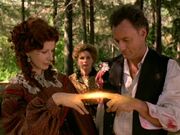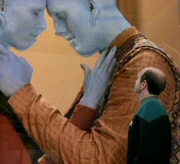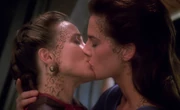

Two Bolians courting
Sexes (or genders) are the divisions between different members of a species of lifeforms. The divisions are usually naturally evolved to biologically facilitate the combination of life processes for the creation of offspring.
- See: Reproductive system (Anatomy)
In many humanoid species, and other lifeforms related to them by evolution, this involves a combination of two or more individuals' genetic material. It is also possible for members of certain species with compatible or related genetic structures to practice inter-species reproduction.
Many species facilitate this bonding with some form of a wedding ceremony.
Gender
- " In spite of human evolution , there are still some traits that are endemic to gender." - Deanna Troi
Many familiar races and cultures are based around the division between "male" and "female" -- a two-sex system where the male adds a genetic seed to be combined with the female's genetic seed in a process also called sex. Many more advanced life-forms still maintain such distinctions; even the powerful members of the Q Continuum have found that they can practice two-party reproduction in this manner. (VOY:"The Q and the Grey") Gender is a cultural construction that often, but not always overlaps the biological division.
There are also various alien sexual makeups which consist of different combinations of genders:
- androgynous
- This refers to an individual (or species) which has neither male nor female functions. Species of this nature have uniform and identical sexual characteristics and functions for the creation of offspring. Although simpler life-forms, like amoebae, simply divide their genetic material to procreate, more advanced life-forms.
- Xindi-Insectoids are genderless and reproduce asexually. (ENT: "Hatchery")
- The J'naii reproduce by recombining the genetic material of two individuals, but without assigning either of them a gender role in the sexual process. (TNG:"The Outcast")
- hermaphroditic
- This refers to an individual (or species) such as the Tholians, which has two or more sexual characteristics or biological functions combined. Unlike the androgynous, hermaphrodites have the capability of being male or female during a sexual process, or undergoing a functional transformation from one gender to another.
- In non-canon novels of the Star Trek: New Frontier series, the Hermat species is described as having this type of sexual makeup.
- groups
- Some species have more than two sexes, or different capacities are assumed by genders not conforming to the pattern of male/female bonding which seems to be common throughout the galaxy.
- Vissians require three separate genders to reproduce: Male, Female, and a Cogenitor who serves as a catalyst for the fertility of the female. (ENT: "Cogenitor")
- Andorian marriages typically involve four partners and Bolian marriages are known to include co-spouses. (TNG: "Data's Day", DS9: "Field of Fire")
- It was not revealed whether Andorians mate in fours out of biological need for four parents to make an offspring, or if it is a societal requirement. Several non-canon novels and comics (such as the DS9 series) have portrayed Andorians as having four distinct sexes required for mating, however, only male and female Andorians have been referred to onscreen, and no onscreen Andorian child has been referred to as having more than two parents. Other novels portray other cultures having three or more sexes, such as Diane Duane's description of a Horta character as being an "orthomale type B4-A".
- Species 8472 is composed of five different sexes. (VOY: "Someone to Watch Over Me") And Doctor Phlox believed Rigelians to have four or five genders. (ENT: "Cogenitor")
Sexuality
In many societies, the drive to procreate and resulting emotional attachments cause permanent or long-lasting monogamous relationships, stemming either from a biological or societal need to be bonded to a mate. Some species, like Vulcans, have a telepathic bond which forms between mates. (TOS: "Amok Time")
Many species have complex interactions and communications involved in approving or rejecting a potential mate; chemical adaptations such as attractive pheromones have also been evolved by some lifeforms, such as Orions. (ENT:"Bound")
Deltans are also known to project a strong sexual presence even without physical contact which may include pheromones and some sub-conscious telepathic elements; the effects are sufficiently strong as to influence other species. (Star Trek: The Motion Picture)
This drive can also lead individuals to enter a relationship or mate for reasons of satisfaction or emotional fulfillment rather than procreation. Individuals of many species throughout creation have also been known to enter into non-reproductive homosexual relationships. Many individuals encountered in the mirror universe have been known to seek out homosexual attachments. (DS9: "The Emperor's New Cloak")
- Unless human nature has changed between modern times and the era of Star Trek, there are probably many homosexual individuals throughout the human culture of the future, but they are rarely specified as such in any canon sense. Federation culture does not seem very sexually repressive, so it is likely that all heterosexual, bisexual, homosexual or transgender members of their society are regarded as equals, and as such, none of the people seen on Star Trek have had any need to present or justify any of their sexual preferences unless it occurred in the course of an episode or movie, therefore we have very little information about their sexual culture. However, behind-the-scenes information suggests the lack of homosexual relationships on Star Trek is more plausibly explained by prevalent American social taboos, as the television series and films tend to avoid addressing what it is like to be gay in the future. The production team over the years has stated that they do not want to create a "token" homosexual character for the express purpose of the issue, anymore than they want to create a black character purely to address racial issues. Of course, this was a bit of a red herring as Star Trek was filled with black characters; it was devoid of homosexual ones.

Kahn and Dax consider reassociation.
While Beverly Crusher ended her relationship with Odan in female form and Jadzia Dax ended her relationship with Lenara Kahn the reasons given were not due to sexual preference. Crusher sited the changing of host bodies and Dax's reason was the tabooed act of reassociation. (TNG: "The Host"; DS9: "Rejoined")
- In fact despite homosexual relationships being present in both episodes their existence was never directly addressed on screen.
Although this is regarded as a personal choice in many Western cultures, various societies through history have discouraged various forms of homosexuality, or a wider range of non-reproductive sex, considering such diversions as a deviation from their biological norm. Other cultures have not; in fact, homosexual rituals are a part of many seemingly primitive tribes and cultures. More tolerant cultures accept these expressions, but many consider any sexual expression to be private and discourage public display or disclosure of an individual's sexuality. Some cultures, such as the J'naii, have been known to enforce laws prohibiting the occurrence of sexual acts considered deviant by the majority of the population. In their case, any individual who adopts a gender is given psychotectic treatments to restore them to the species' androgynous norm. (TNG:"The Outcast")
- Many comics, games and novels have taken much more liberty than filmed Star Trek in describing attitudes about sexual freedom and homosexuality in alien cultures. Star Trek creator Gene Roddenberry in particular was known for adding many sexual themes to his creations. Some of his drafts for stories from the unproduced Star Trek: Phase II series would have been the inclusion of scenery from Earth portraying it as a nudist paradise. Some of his contributions of this nature ended up influencing the story of the Edo in "Justice" (TNG).
In the Federation, contraception injections are available to those who wish to practice sex without it resulting in reproduction. (TOS: "The Mark of Gideon"; DS9: "The Dogs of War")
Until 2373, the Q had never mated before, as they felt that they were "way beyond sex." Nevertheless, Q and Q (female) mated producing a son nicknamed Junior. (VOY: "The Q and the Grey")
Alien reproduction
- Betazoid mating
- Denobulan mating
- Risian mating
- Klingon mating
- Ocampa mating
- Orion mating
- Varro mating
- Vulcan mating
- Xyrillian mating
